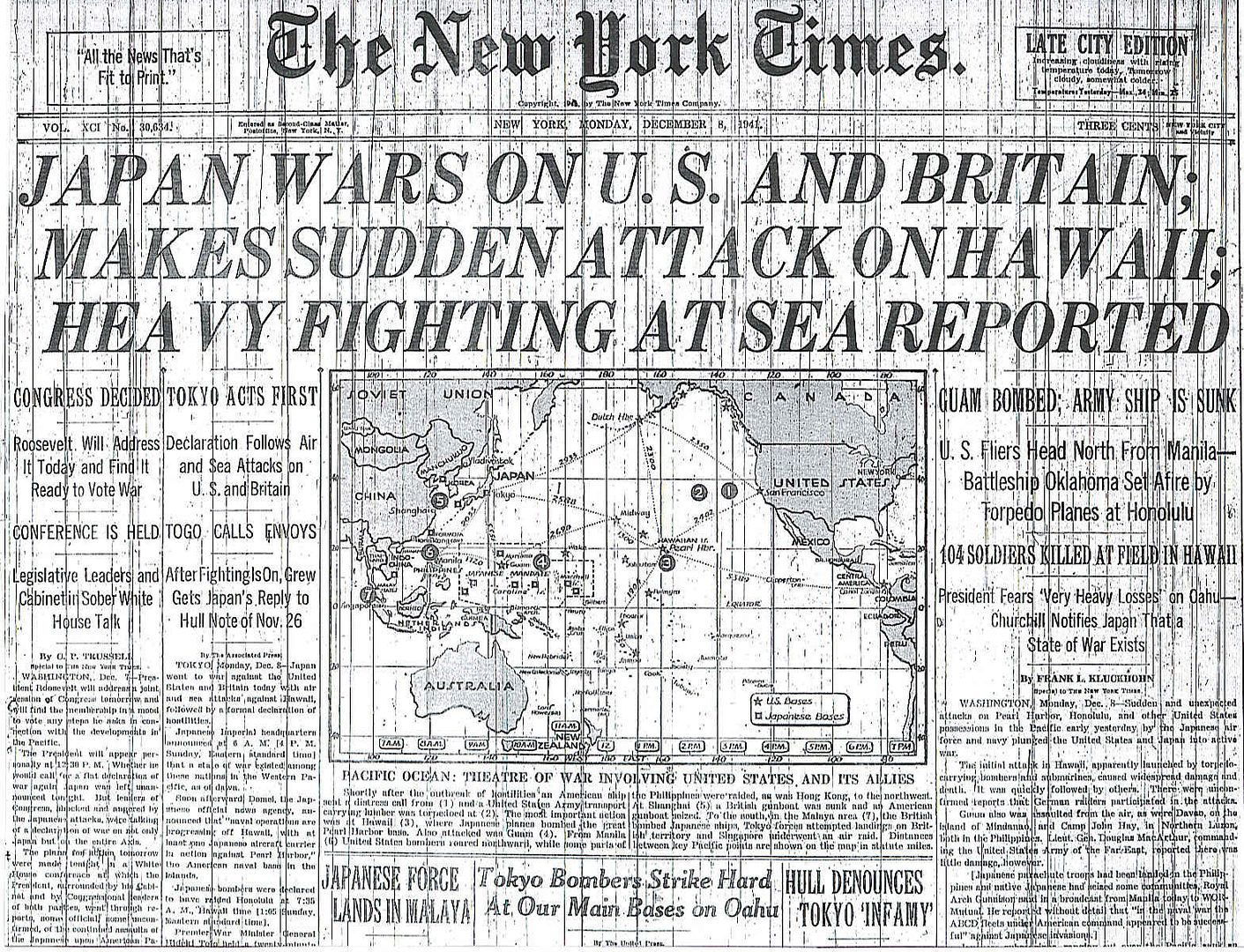
Posted on 12/08/2011 5:11:40 AM PST by Homer_J_Simpson

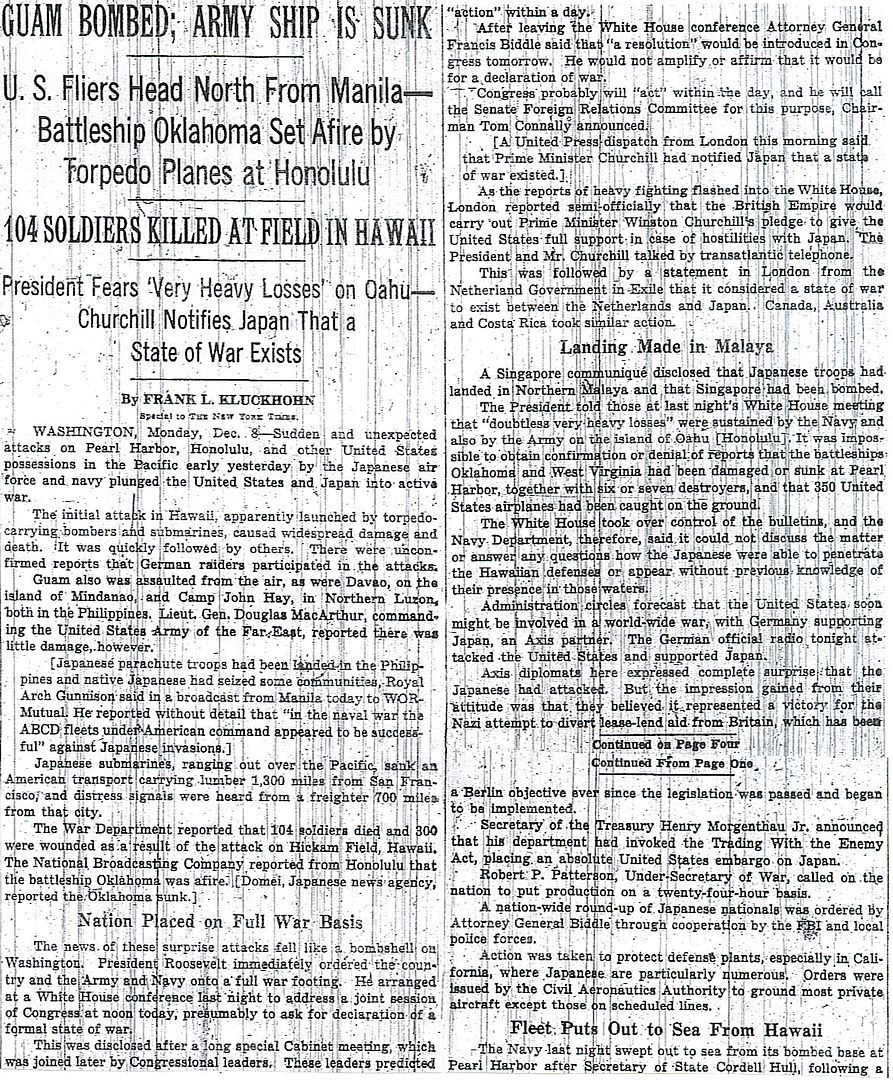
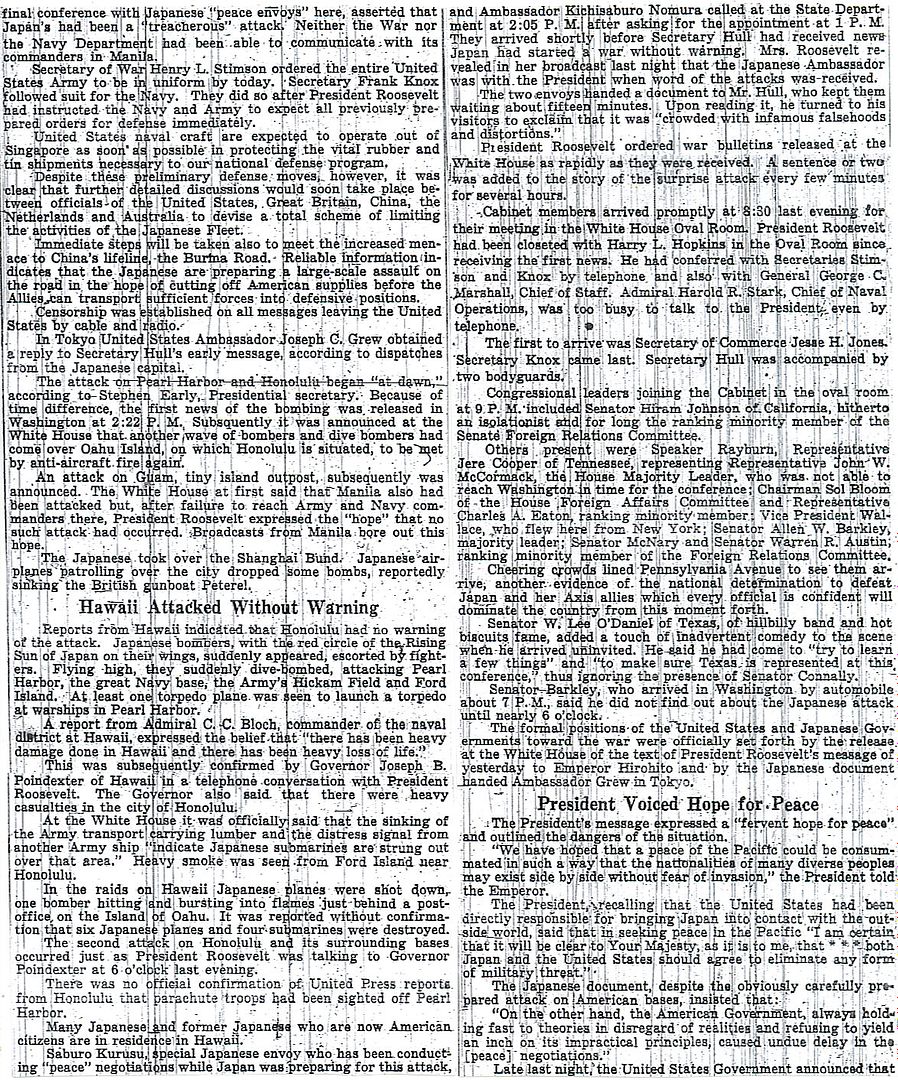
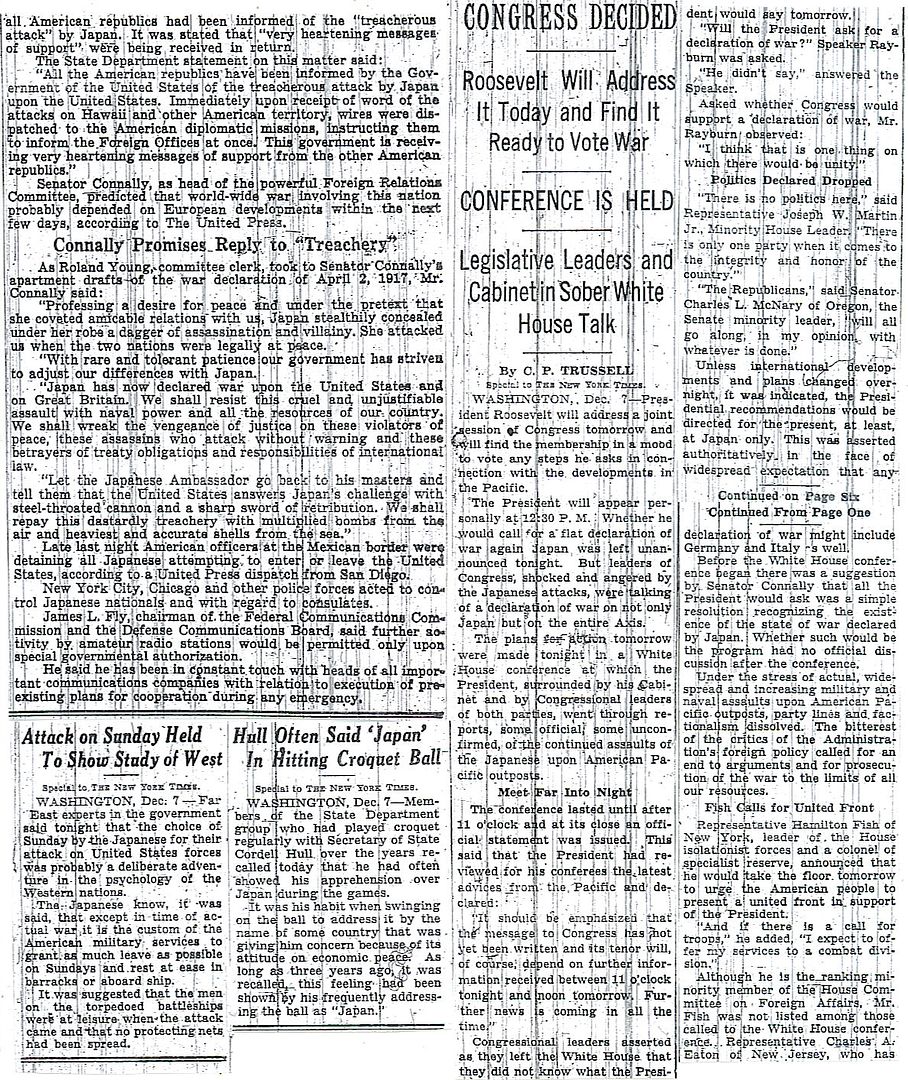
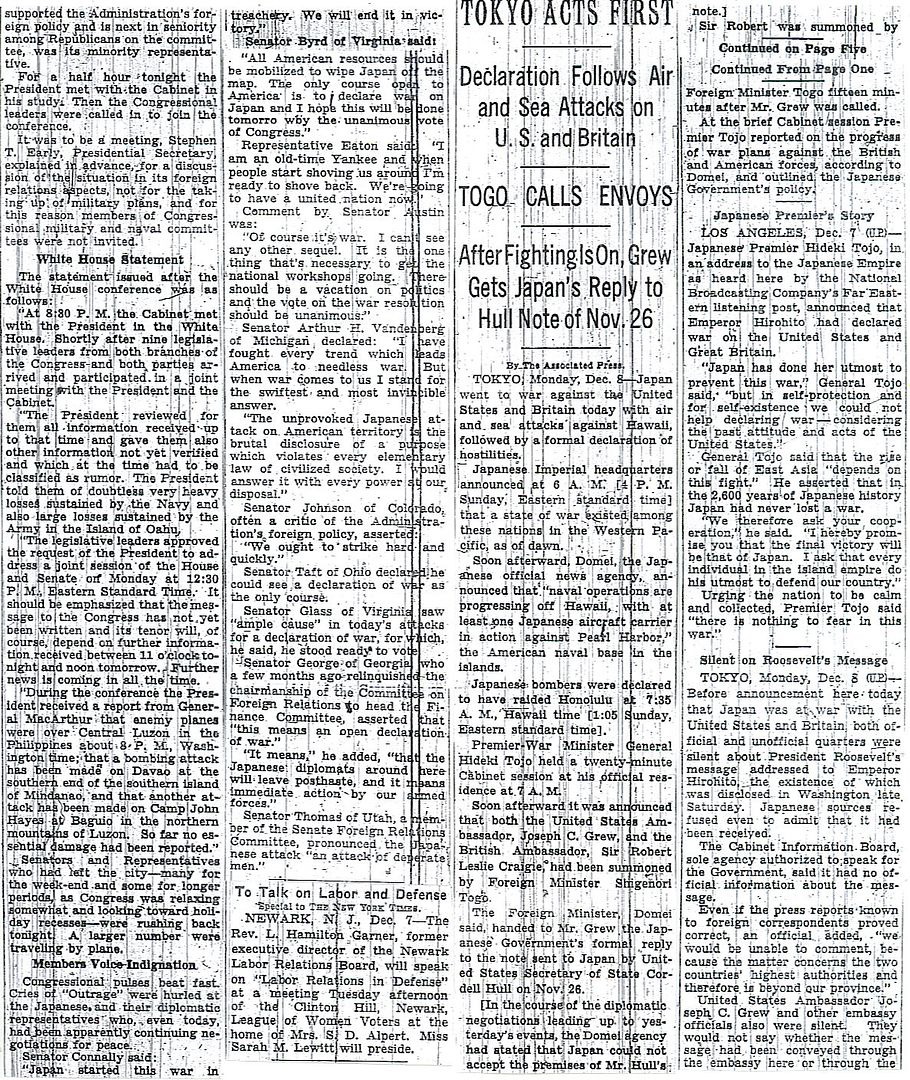

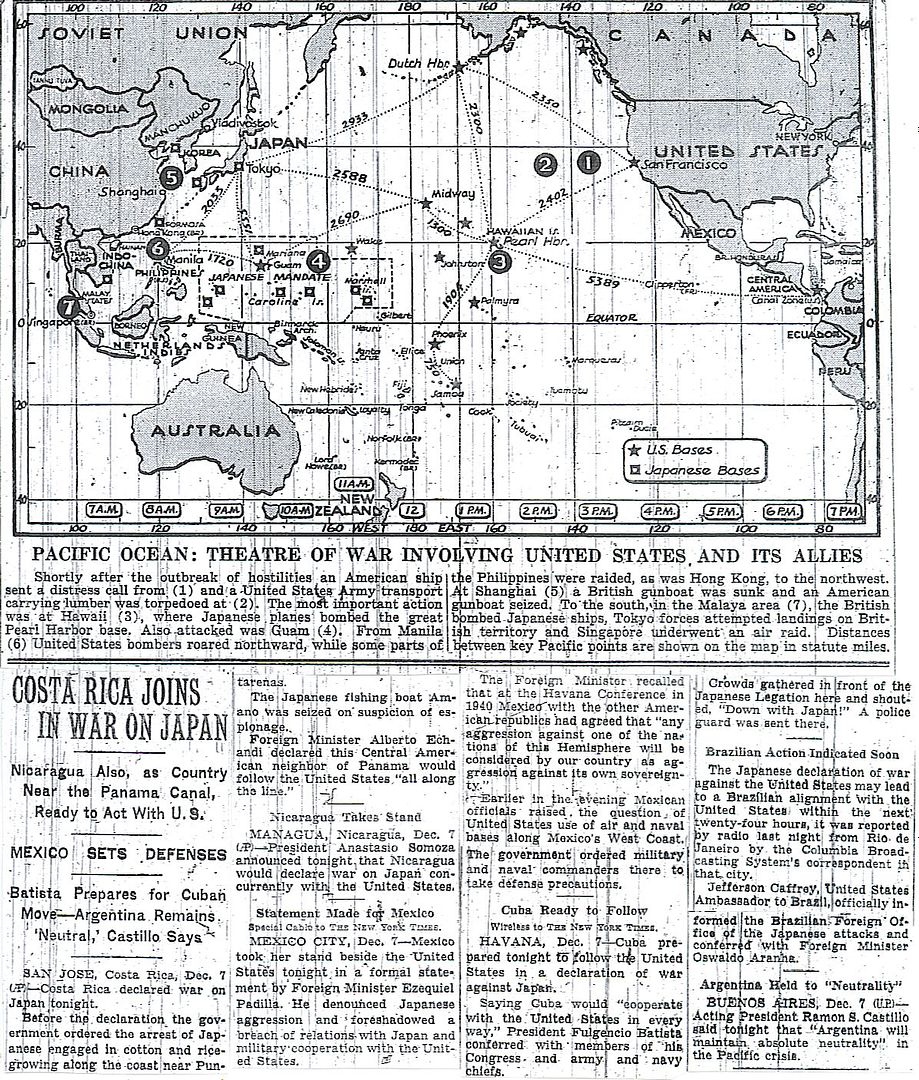
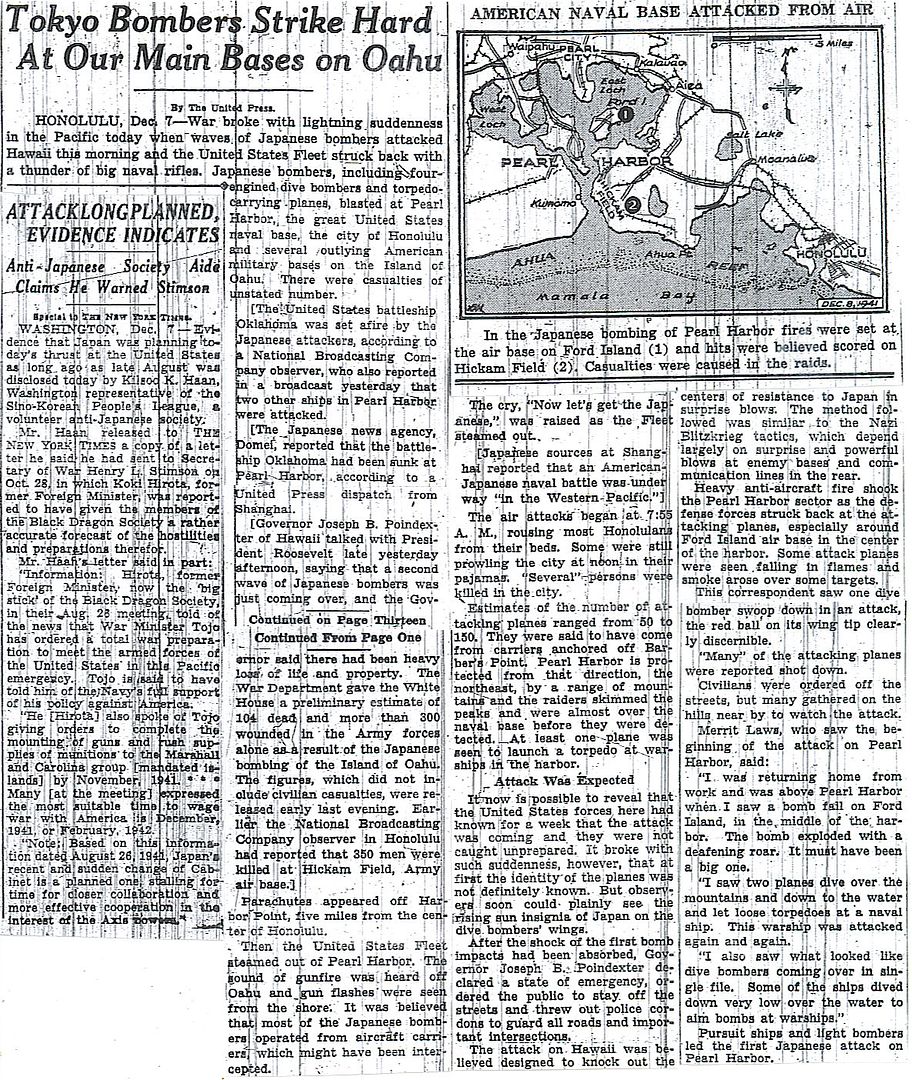
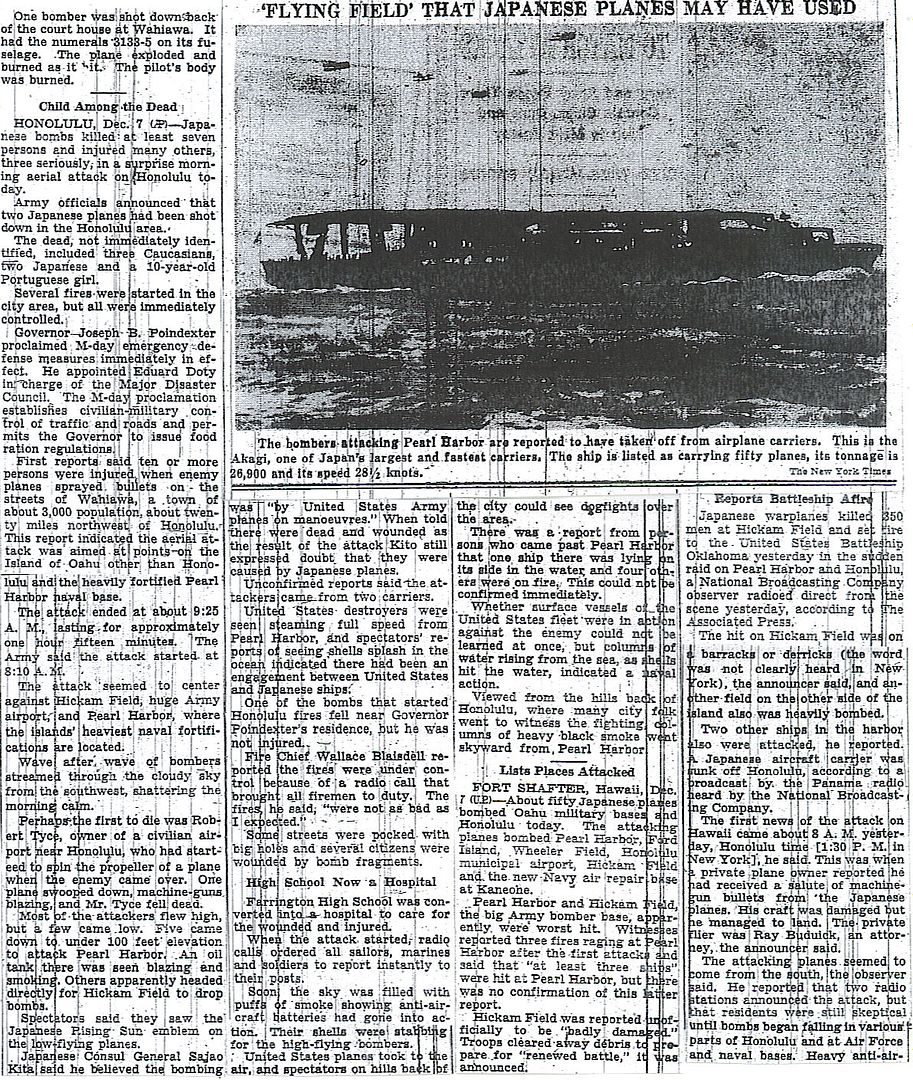

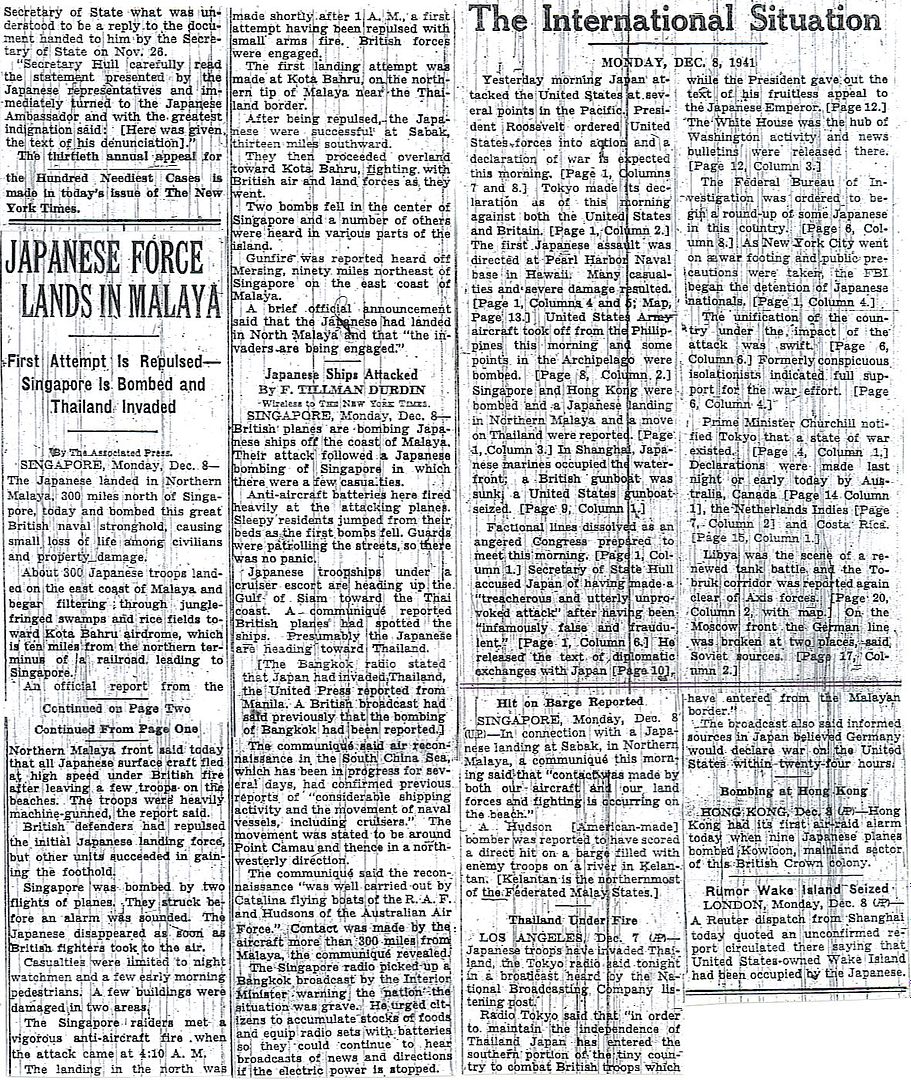

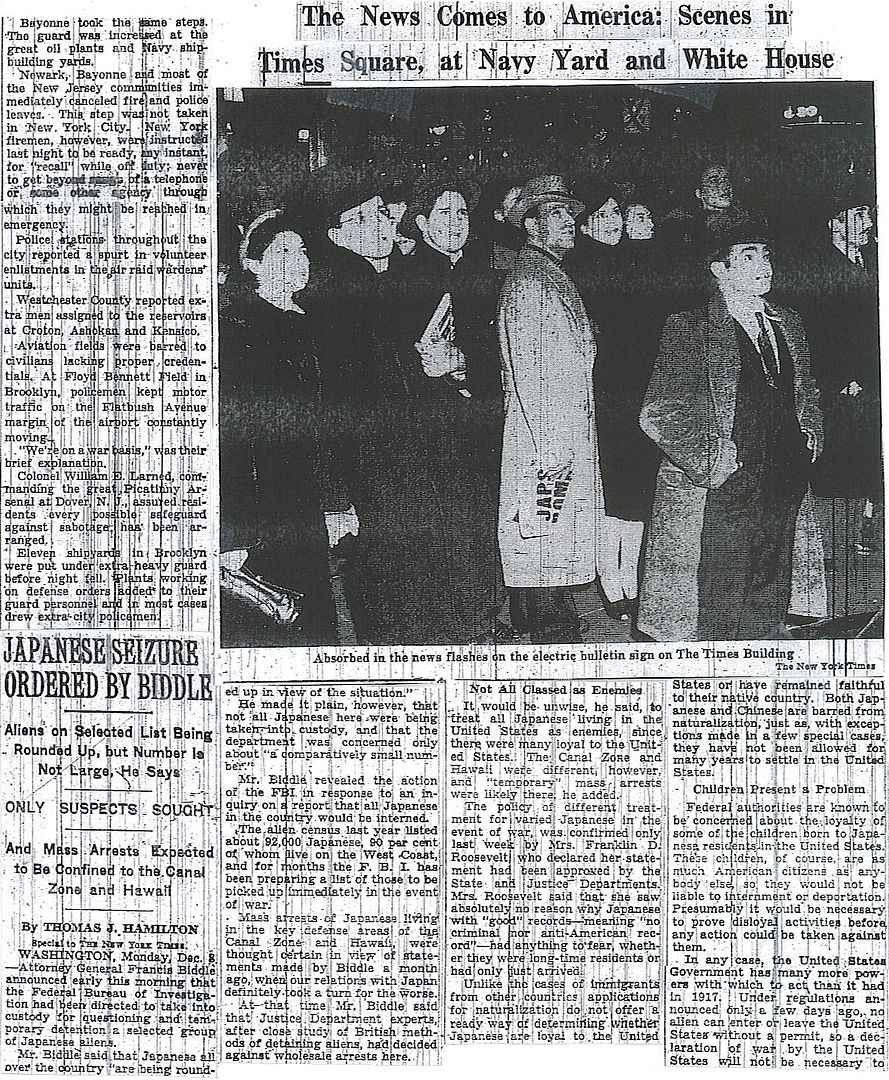
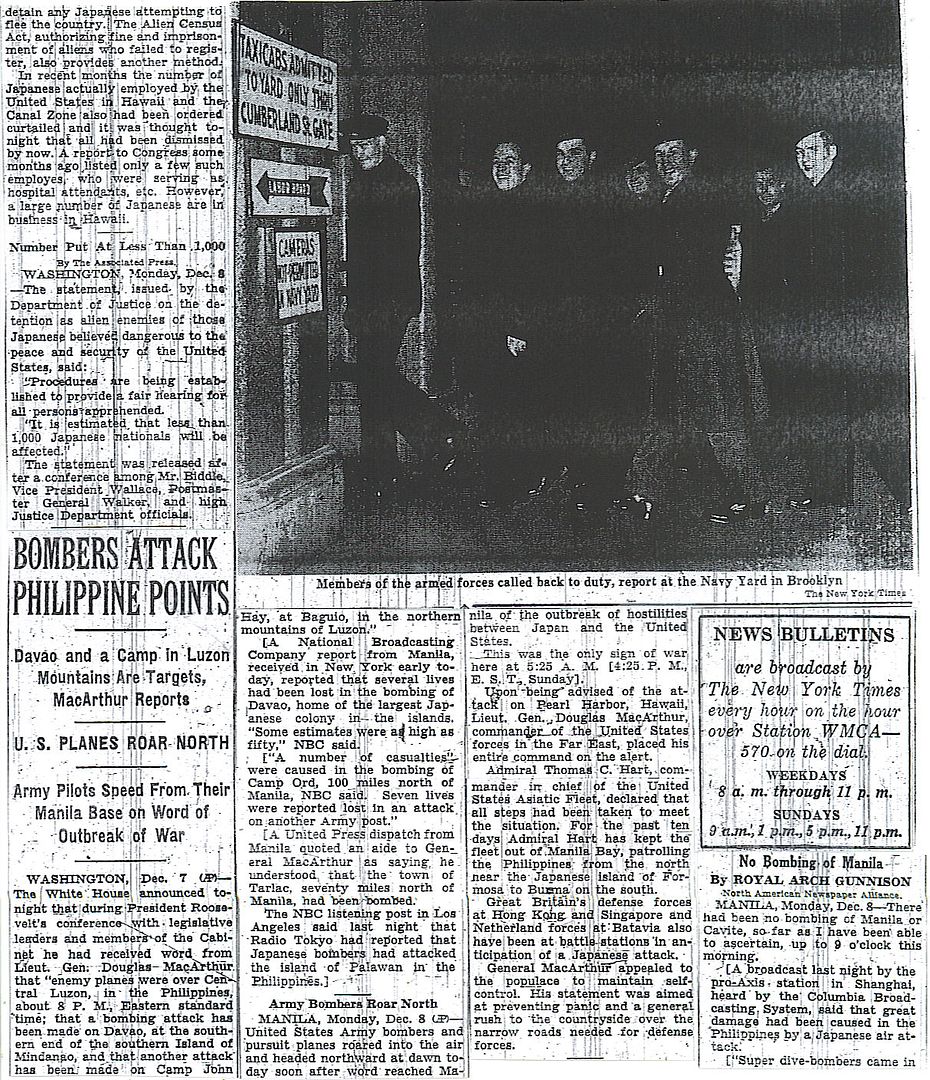

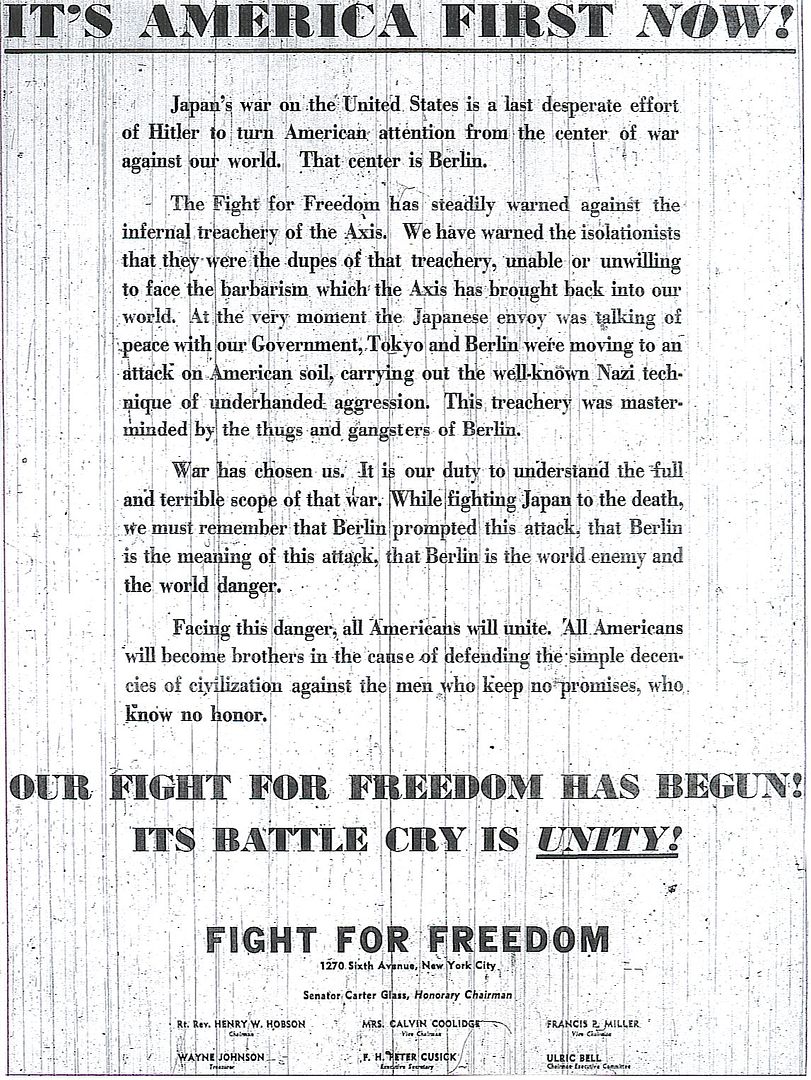
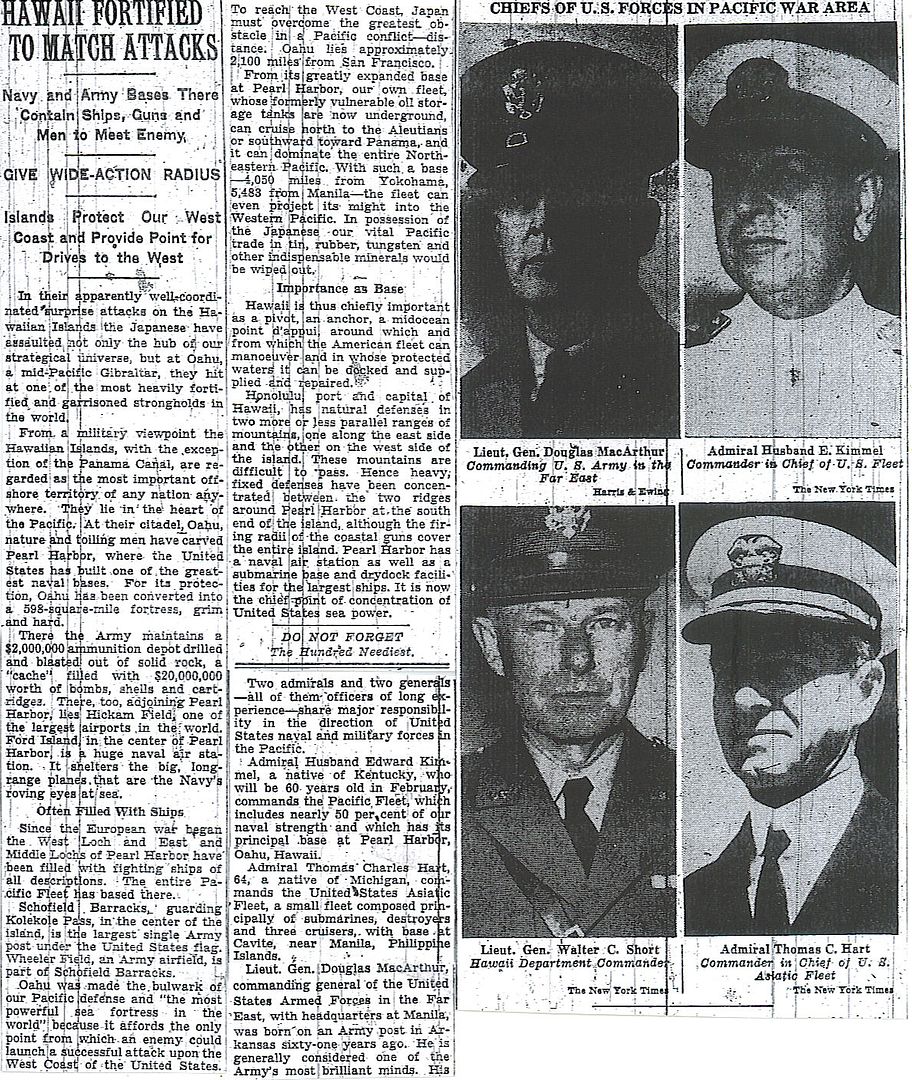
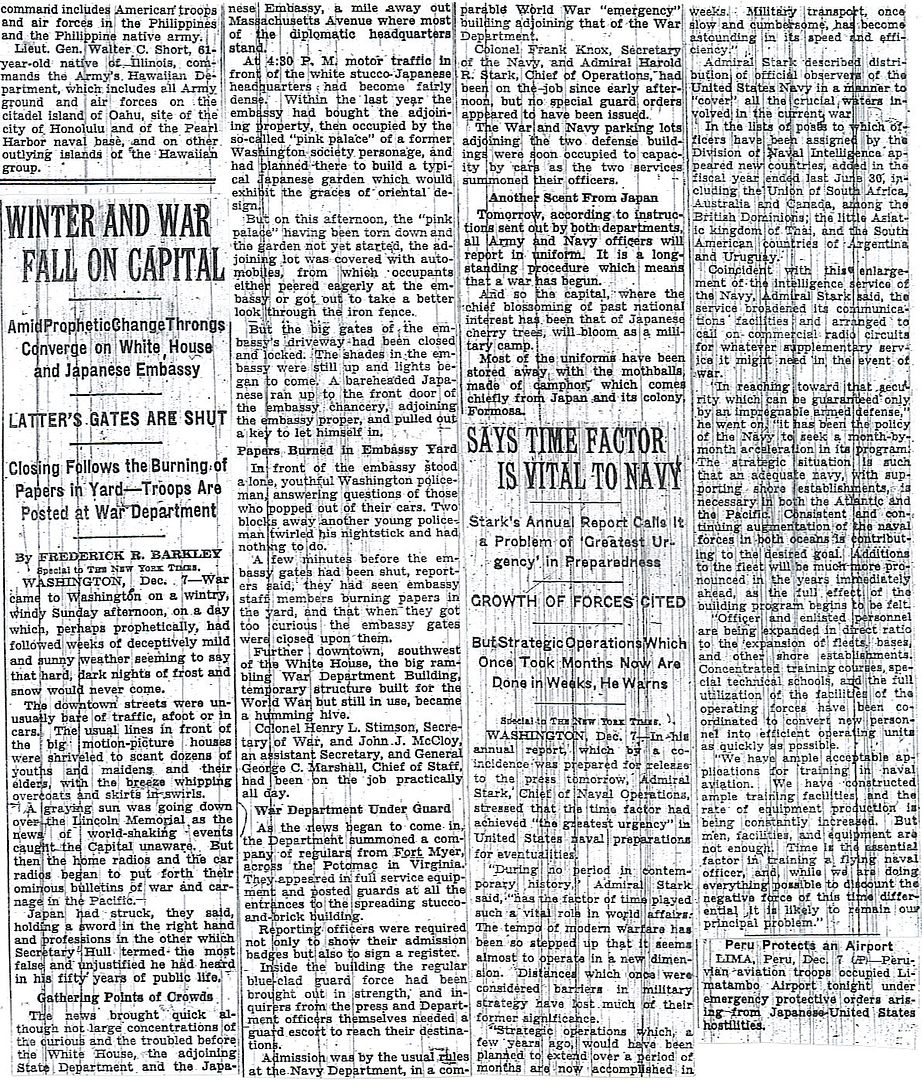

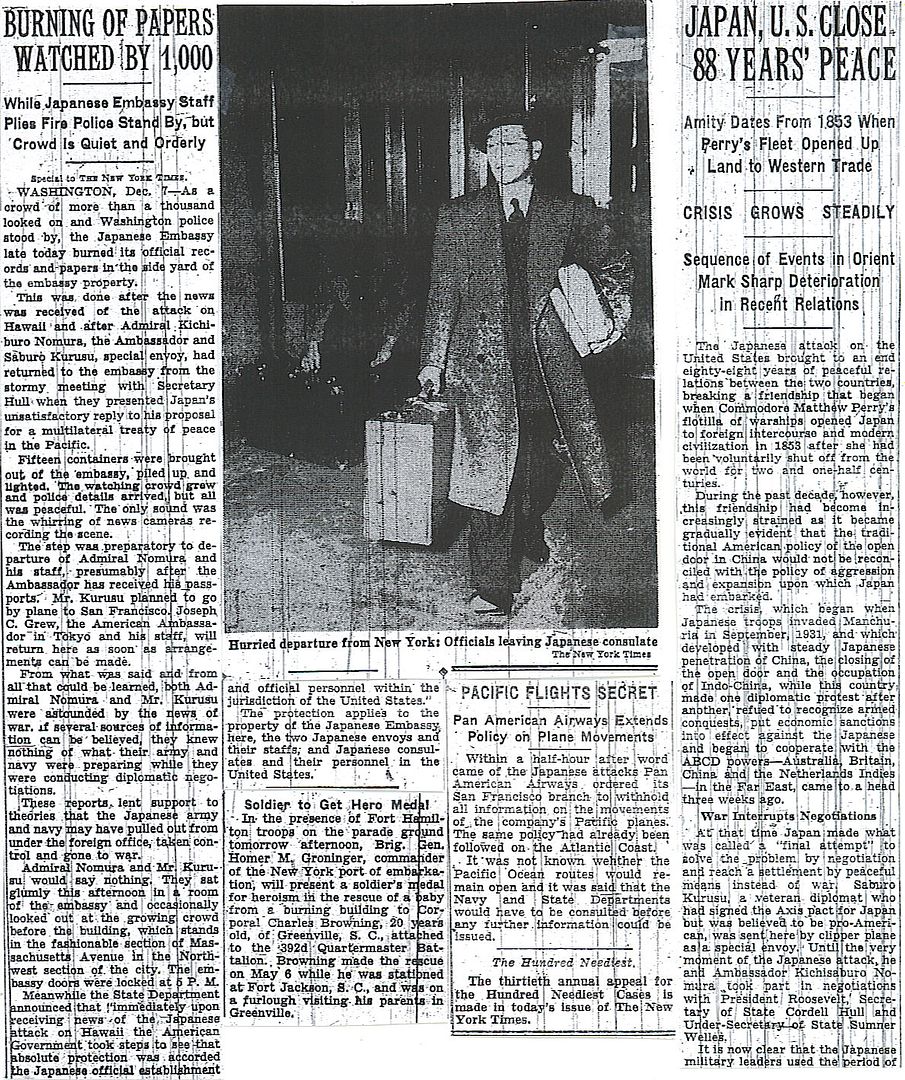

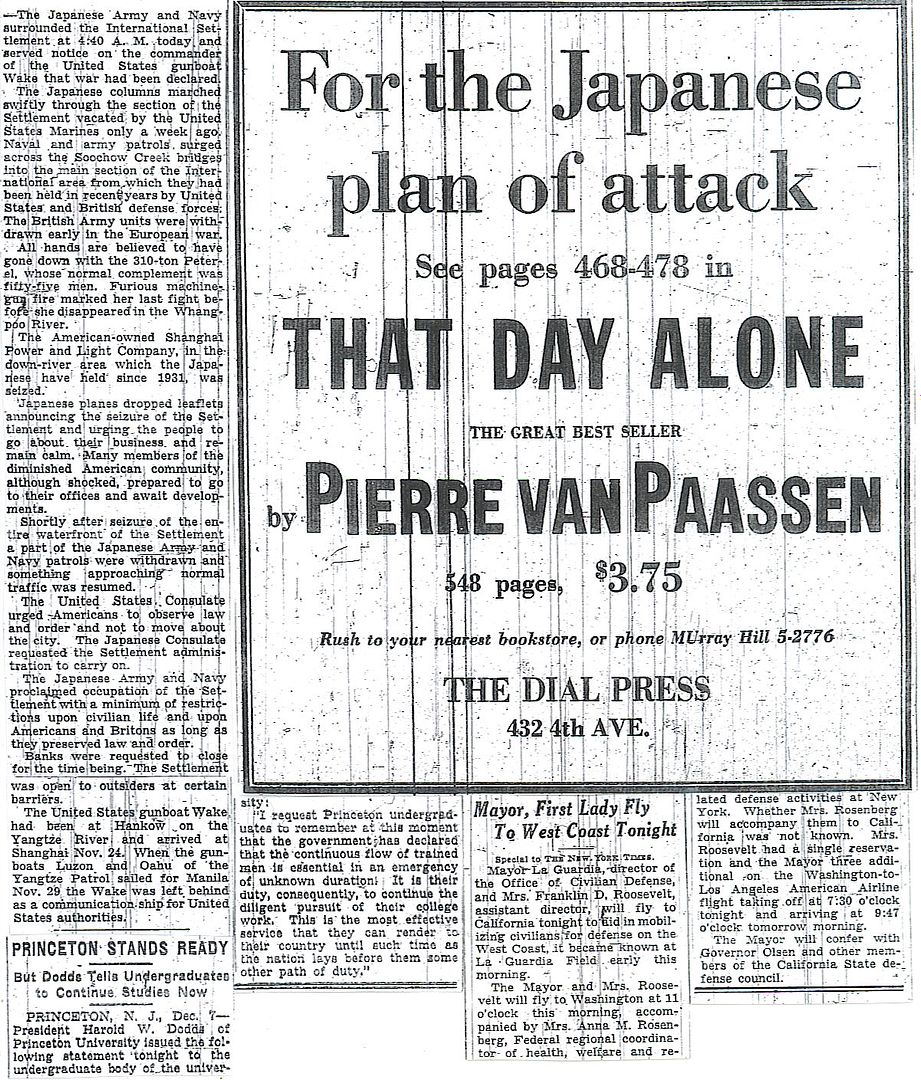

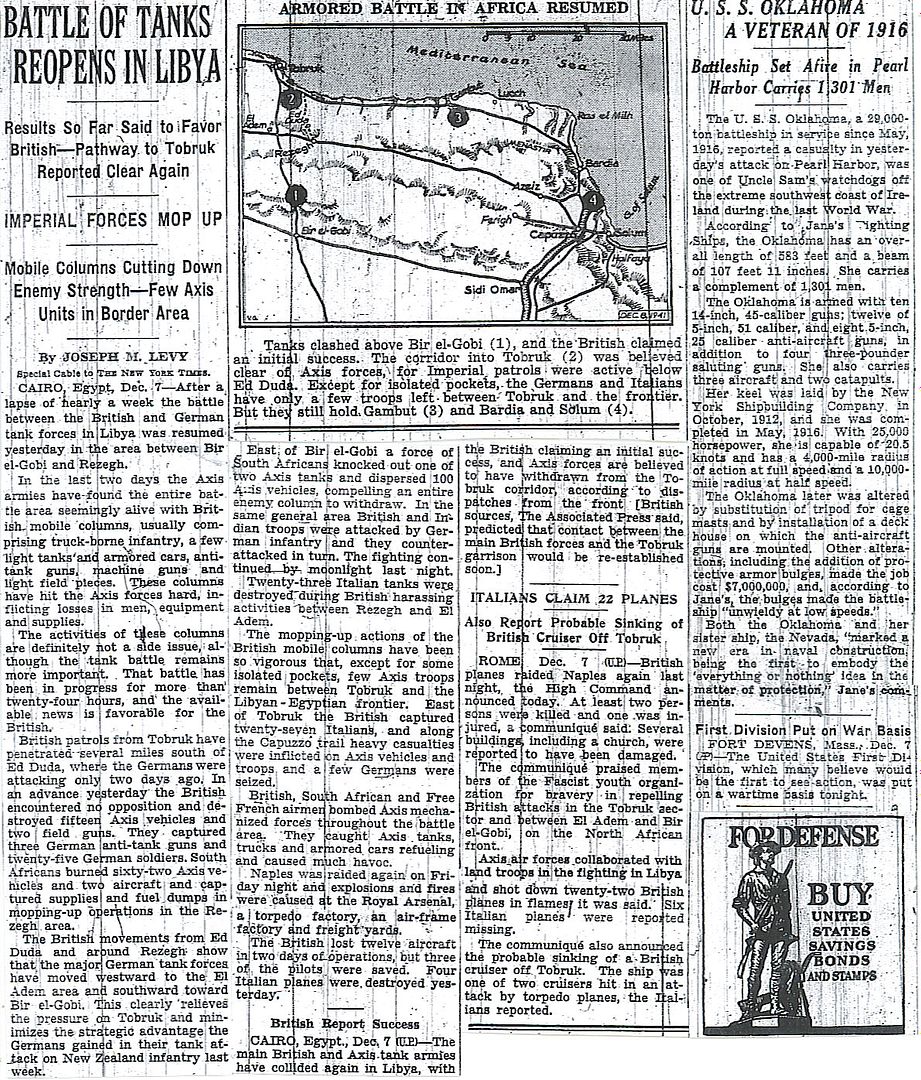

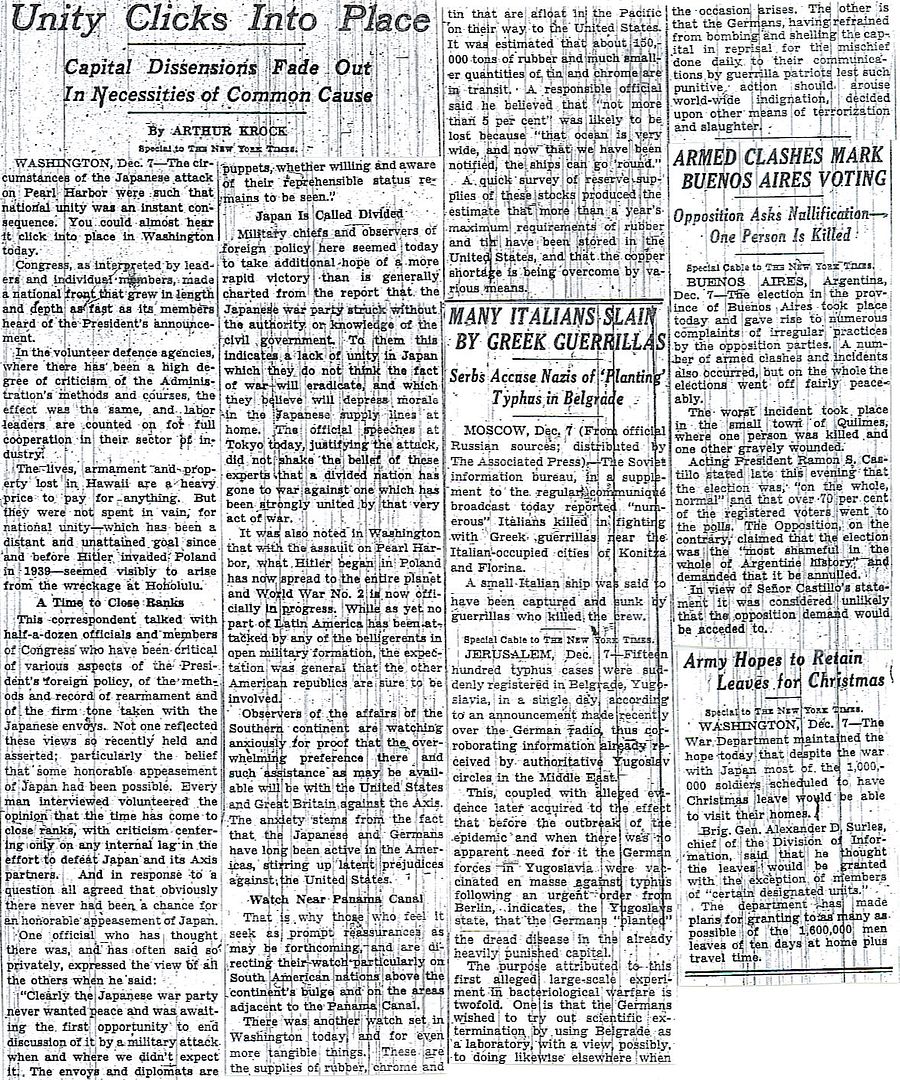
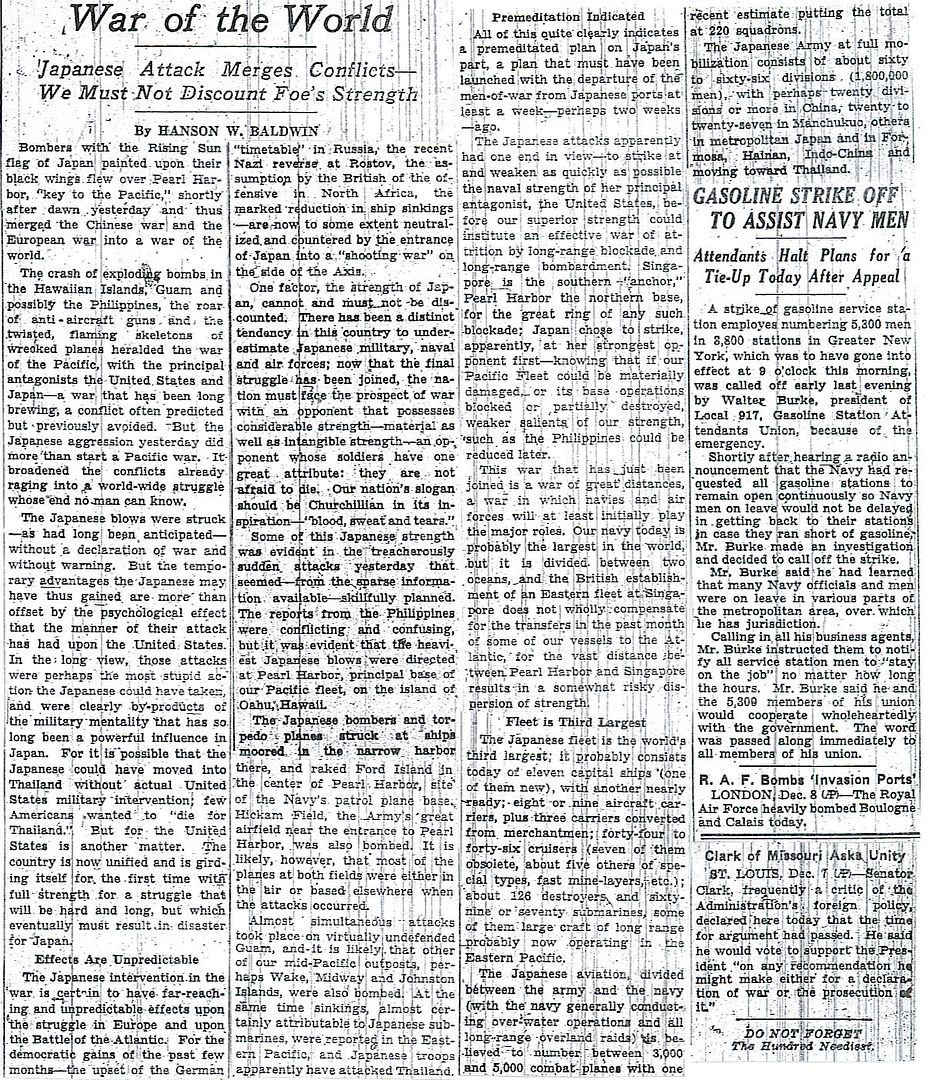
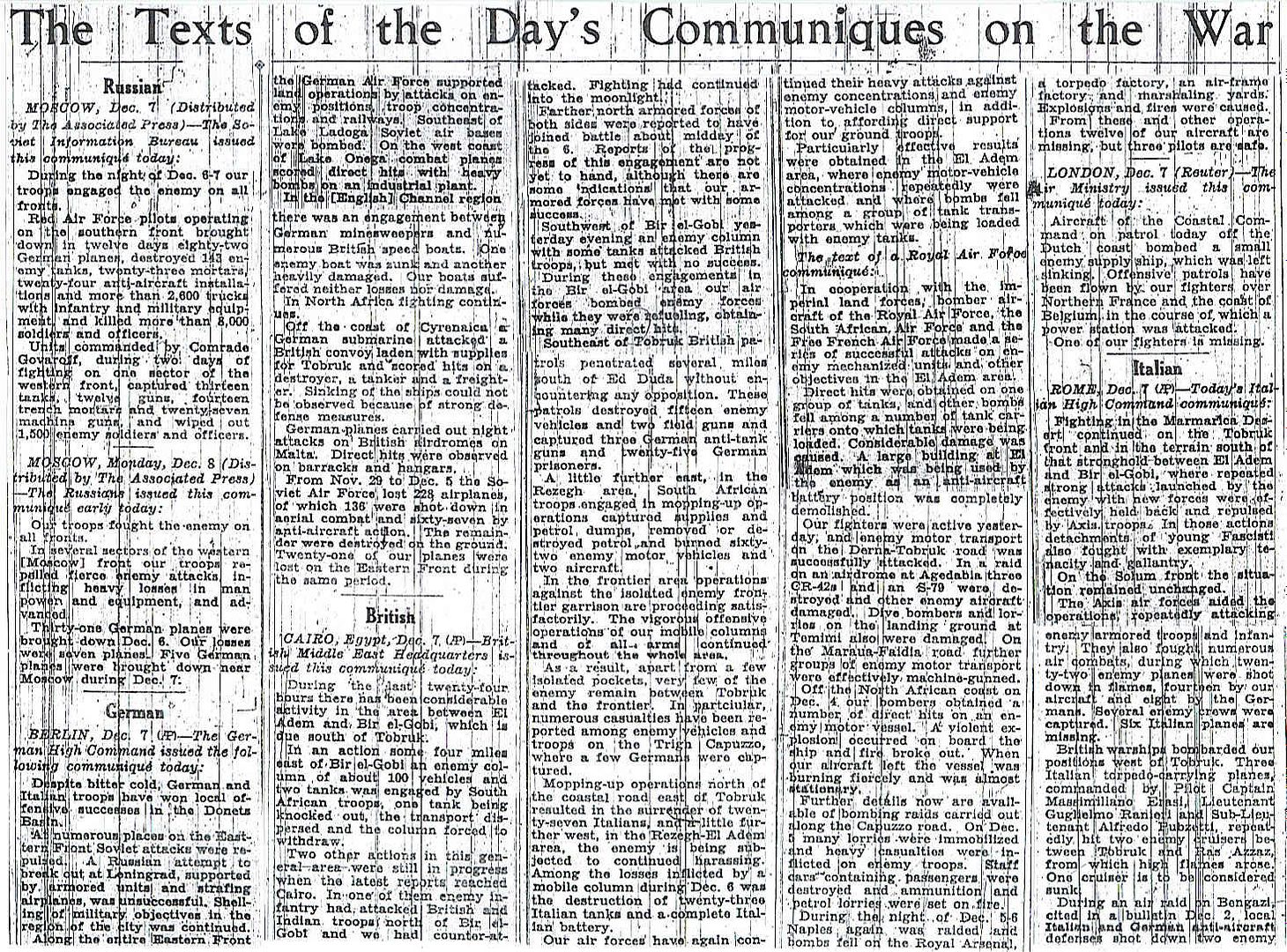


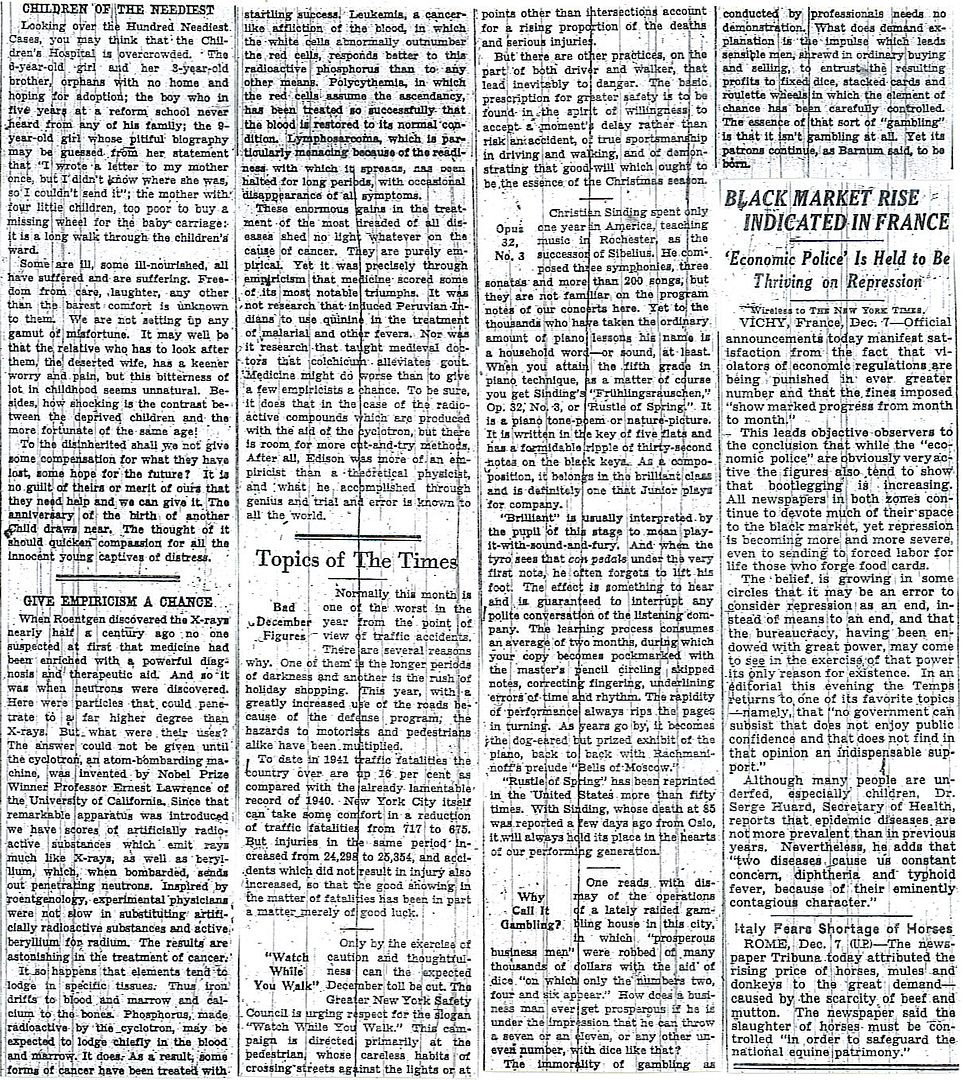
Thank you, Homer.
Late last night American officers at the Mexican border were detaining all Japanese attempting to enter or leave the United States, according to a United Press dispatch from San Diego.
Oh, how things have changed.
Guam Bombed: Army Ship is Sunk – 2-4
Attack on Sunday Held to Show Study of West – 4
Hull Often Said ‘Japan’ in Hitting Croquet Ball – 4
Congress Decided – 4-5
Tokyo Acts First – 5-6
Wheeler Backs a War on Japan – 6
Text of War Declaration by Hirohito – 6
Pacific Ocean: Theatre of War Involving United States and Its Allies (map) – 7
Costa Rica Joins in War on Japan – 7
Tokyo Bombers Strike Hard at Our Main Bases on Oahu – 8-10
Attack Long Planned, Evidence Indicates – 8
‘Flying Field’ that Japanese Planes May Have Used (photo) – 9
Hull Denounces Tokyo ‘Infamy’ – 10-11
Bulletins on Orient War – 10
Japanese Force Lands in Malaya – 11
The International Situation – 11
Entire City Put on War Footing – 12-13
Japanese Seizure Ordered by Biddle – 13-14
The News Comes to America: Scenes in Times Square, at Navy Yard and White House (photos) – 13-15
Bombers Attack Philippine Points – 14-15
Tokyo Radio Broadcasts a Talk on ‘Good Morals’ – 15
Hawaii Fortified to Match Attacks – 17
Chiefs of U.S. Forces in Pacific War Area – 17-18
Winter and War Fall on Capital (by Frederick R. Barkley) – 18
Says Time Factor is Vital to Navy – 18
West Coast Acts for War Defense – 19
Home-Bound Americans on Japanese Ship at Sea – 19
Burning of Papers Watched by 1,000 – 20
Japan, U.S. Close 88 Years of Peace – 20-21
U.S. Gunboat Lost in Shanghai Blow (by Douglas Robertson) – 21-23
Mayor, First Lady Fly to West Coast Tonight – 22
Nazi Line Broken, Moscow Claims – 23
Axis on Defensive over Soviet Front (by George Axelsson) – 23
Battle of Tanks Reopens in Libya (by Joseph M. Levy) – 24
U.S.S. Oklahoma a Veteran of 1916 – 24
Japanese Attack Charged to Hitler – 25
Nazi Report of Sea Fight in Pacific is Roundabout – 25
A Lonely Prisoner on the Western Front (photo) – 25
Unity Clicks into Place (by Arthur Krock) – 26
Many Italians Slain by Greek Guerrillas – 26
Armed Clashes Mark Buenos Aires Voting – 26
Army Hopes to Retain Leaves for Christmas – 26
War of the World (by Hanson W. Baldwin) – 27
Gasoline Strike Off to Assist Navy Men – 27
The Texts of the Day’s Communiques on the War – 28-29
Nazis Push Demands for Aid in Policing – 29
The Ambassador from Moscow Arrives in Washington (photo) – 30
Editorials – 30-31
War With Japan
Amend the Wagner Act
Kingsborough Houses
Children of the Neediest
Give Empiricism a Chance
Topics of the Times
Black Market Rise Indicated in France – 31
http://www.onwar.com/chrono/1941/dec41/f08dec41.htm
America declares war on Japan
Monday, December 8, 1941 www.onwar.com
Roosevelt signs the declaration of warIn Washington... President Roosevelt addresses Congress, declaring December 7 “a date which live in infamy” . War is declared upon Japan by both the Americans and British. Australia, New Zealand, the Netherlands, the Free French, several South American countries also declare war upon Japan. China declares war upon Germany, Italy and Japan. The latter is a formal declaration only as a de facto state of war has existed between China and Japan for 7 years.
In the Philippines... The Japanese attack begins with the capture of Bataan Island and the creation of an airstrip for plane refueling. Japanese invasion troops leave Paulau for the Philippines. The main attack begins with massive air bombardment which reduces the American defenses to 17 B-17’s and less than 40 fighters. Most of the planes are destroyed on the ground. American General Douglas MacArthur has under his command 130,000 troops (20,000 Americans). His plan to defend the island becomes nonviable after the destruction of the main portion of the his air force and the losses at Pearl Harbor.
In Malaya... Japanese troops (18th Division) begin landings at Kota Bharu protected by two battleships and six heavy cruisers under the command of Admiral Kondo. The following morning, troops (5th Division) as well as tank units are landed at Singor and Patini in Thailand. The British defenders under command of General Percival, have 3 divisions in Malaya but almost no tanks. Only one division is not committed to static defensive positions around air fields and possible landing sites. Of the 158 RAF planes, most are destroyed on the ground and the airfield at Kota Bharu is captured intact by the Japanese.
In Singapore... The British battleship Prince of Wales, the battle cruiser Repulse and four destroyers sail from Singapore to aid in the fighting in Malaysia.
In Thailand... Fears of offending American public opinion by violating Thailand’s neutrality have prevented the British from preparing defenses in Thailand and difficulties with Thai border guards prevent a quick response to the Japanese landings further north.
On Wake Island... Air attacks by the Japanese continue. A small landing force leaves Kwajalein escorted by a cruiser and two destroyers.
In Hong Kong... The Japanese 38th Division attacks the British garrison with only six battalions and 28 guns. British and Canadian troops begin a retreat to the “Gindrinkers Line.”
In Shanghai... Japanese troops occupy the city and capture a small US garrison in the foreign section.
On the Eastern Front... Soviet counteroffensive continues to press the Germans westward
Red Army is also advancing in the Leningrad sector.
In North Africa... Rommel begins the withdrawal from the siege of Tobruk in an orderly retreat. German strength in the area has been reduced to 40 tanks and the 90th Light division to the strength of two battalions.
Interesting...per the map on the front page. I had no idea there was a US ship torpedoed in between HI and the west coast.
Usually just lurk and read (like so many others) but had to throw out another “thanks” for the great stuff.
http://homepage.ntlworld.com/andrew.etherington/month/thismonth/08.htm
December 8th, 1941
UNITED KINGDOM: London: A special session of parliament was held today to hear the prime minister explain Britain’s declaration of war against the Japanese empire. Churchill told MPs that he had intended to time Britain’s declaration to follow America’s, which required the approval of Congress.
But then news reached London of a Japanese landing in Malaya. The cabinet at once approved the declaration, which was delivered to the Japanese envoy at 1pm today. In his broadcast tonight, the prime minister gave a warning that the extension of the war will lead to a shortage of warplanes for the next few months.
FRANCE: Paris: Rue des Maronites. Attempted shooting of a French policeman.
POLAND: Chelmno: In what could be a new stage in the much-discussed Nazi programme to annihilate the Jews, all the 700 Jews evacuated here from Kolo have been murdered.
In groups of 80, they were loaded into the back of a van. The exhaust pipe led straight into their compartment; the fumes suffocated them all. The van reached a wood where it disgorged its grisly contents. The corpses gold teeth and fillings were extracted with pliers. Their clothes and jewellery having been removed, the dead Jews were thrown into a mass grave.
GERMANY: Rastenburg: Hitler admits that the eastern Blitzkrieg has failed and orders his generals to prepare for a long struggle.
FINLAND: The Finnish 4th Division takes defensive positions along southern part of Maaselkä Isthmus. Good defensive positions have been reached on all directions and Marshal Mannerheim and President Ryti decide not to continue attack towards White Sea, because it has become politically unwise, since it has become probable that Germans will lose the war and the US has threatened to declare war if Finns cut the supply of Lend and Lease equipment by taking Archangelsk. (Gene Hansen)
U.S.S.R.: The Russian Army units continue their attacks and gain ground in both the Moscow and Leningrad sectors.
NORTH AFRICA: With 40 German tanks remaining, Rommel abandons the fight around Tobruk and starts a withdrawal. Between now and the 11th he will move his units back to Gazala. This shortening of his supply lines will help.
THAILAND: Simultaneously with the attack on Pearl Harbor, on the other side of the international dateline, Japan invades. The Thai government surrenders.
HONG KONG: Japanese aircraft destroy the five planes on the RAF Kowloon airfield.
CHINA: River gunboat HMS Peterel acting as communications centre for the British Consulate in Shanghai, is boarded by Japanese Naval forces on this day and given an ultimatum. When the ultimatum expires IJN cruiser Idzumo opens fire and sinks her in the port of Shanghai. (Alex Gordon)(108)
On night duty at the Bubbling Well police station, SMP sergeant Ted Quigley received a call from the Central station at 0040. The caller reported that Japanese troops had crossed over the Garden Bridge from Hongkew and were deploying artillery pieces along the Bund. In less than an hour, the Second World War in the Pacific would begin with the Japanese attack on Kota Bahru in Malaya, followed seventy minutes later with an attack on the American base at Pearl Harbor. The Japanese battleship HIJMS Idzumo had been built in Great Britain in 1899. Though obsolete, it still mounted powerful guns and was a symbol of Japanese might in Shanghai. Anchored in the middle of the Whangpoo, the ship was long a part of warship row. By contrast, the HMS Peterel retained only a few Lewis machine guns, and had been relegated to a diplomatic wireless station. She was only 185 feet long and displaced 310 tons. At 0420 a launch carrying Captain Inaho Otani, head of Japanese naval intelligence in Shanghai and a small party of Japanese sailors, approached the Peterel. After boarding her, Otani informed her commander, Lieutenant Stephen Polkinghorn, that Japan had declared war on Great Britain and, in order to keep the peace in Shanghai, he should surrender his ship. He then presented a written summons to surrender. Polkinghorn roared his response: “Get off my bloody ship!” The Japanese retreated down the gangway and the launch retired. When it was about one hundred yards away a red signal light was fired from the launch. Instantly, the roar of cannons split the night as the Idzumo, along with a Japanese gunboat, destroyer, and the artillery pieces on shore all opened up at point blank range. Peterel’s two Lewis machine guns went into action. But within minutes, it was all over. Peterel, a ball of flame, sank into the Whangpoo. Six crewmembers were killed and several were wounded. The surviving crew swam to the French Bund; many were picked up by Chinese in sampans who braved the burning oil and gunfire. Three of her crew had been ashore. Two of them gave themselves up within days, but the third, Petty Officer Telegraphist James Cuming, evaded Japanese capture for the entire war and worked with a Chinese resistance ring. A Japanese delegation to USS Wake found her captain not present; the ship surrendered. Living with his family in an apartment at the Customs House on the Bund, David Nicoll was awakened by the firing and thought Chinese troops were attacking a harbor installation. Wendal Furnas, in his room at the Foreign YMCA near the racecourse, thought stores of Chinese black market gasoline had exploded. Others heard the explosions, but went back to bed, until awakened by telephone calls. Bertram Monypenny, a sales manager for Lever Brothers, was preparing to “grunt at the wrong number” when the caller, a friend, asked him if he could hear the noise and added that he thought “it has started.” Edwin Easley, a manufacturer’s representative, received several calls reporting the sinking of the Peterel and the seizure of the Wake. At St. John’s University, George Laycock was awakened at 0640 by the sound of planes roaring over the campus. They were flying low over the city, scattering leaflets written in several languages. In them, the Japanese announced that a state of war existed and that lives and property would by protected. (Greg Leck, from his book “Captives of Empire”)
COMMONWEALTH OF THE PHILIPPINES:
1:06 AM: Marshall dispatches warning message to USAFFE. Text.
2:00 AM: Iba radar station detects an airplane or airplanes between Formosa and Luzon and notifies George. George scrambles P-40’s from Iba to intercept. They are unable to locate the intruders and return to Iba.
2:30 AM: Asiatic Fleet picks up message but fails to disseminate this to USAFFE. Army ham operators at Fort Stotsenberg also pick up the message but do not forward this to authorities.
2:55 AM: Lt Col William T Clement, USMC, Asiatic Fleet HQ duty officer, telephones Hart to tell him he is coming to his quarters at the Manila Hotel with an important message.
3:00 AM: Fort Santiago picks up US commercial wire service report on Pearl Harbor attack which contained no details.
3:05 AM: Clement arrives at Hart’s quarters and gives him the message stating Pearl Harbor had been attacked.
3:10 AM: Hart despatches fleet message (text) and calls Purnell. (Weintraub states Hart advised Sutherland but does not cite a source; all other sources insist Asiatic Fleet did not directly notify USAFFE.)
3:15 AM: Akin hand-carries copies of the commercial radio traffic on the Japanese attack on Pearl Harbor to USAFFE headquarters and delivers them to Casey, who then notifies Sutherland; Sutherland relays message to MacArthur by telephone. MacArthur begins dressing, reads Bible.
3:30 AM: Naval Intercept Section at Fort Mills picks up “two messages” indicating attack on Pearl Harbor. The duty officer, Lieutenant Rudie Fabian, calls Captain Bob Brown, Moore’s ADC, who notifies Lt Col William C Braly, duty officer at the Harbor defence Command Post, who puts all harbor defenses on alert.
3:35 AM: Hart arrives at Marsman Building.
3:40 AM: (2:40 pm, 7 December, Washington time) Gerow telephones MacArthur and confirms that Pearl Harbor has been attacked. Gerow may have indicated that there was extensive destruction at Pearl Harbor, though this is uncertain and MacArthur later denied that he was so informed. In any event, there certainly was no direction to commence hostilities against Japan.
3:45 AM: Hart sends out second message to Asiatic Fleet. TEXT
3:50 AM: MacArthur arrives at USAFFE Headquarters. Hart and Sayre are already present and confer with MacArthur until after 5:00 AM.
4:00 AM: Brereton alerted by telephone call from Sutherland, alerts his Air Force to remain at the ready.
4:00 AM: False report of air raid causes anti-aircraft fire to break out in Manila.
4:05 AM: Vargas calls PA HQ (Fort Santiago?) and is advised war has broken out; message is confirmed in second call to USAFFE HQ. Vargas notifies Quezon by telephone.
4:30 AM: (3:30 PM, 7 December, Washington time) War Department sends message to USAFFE advising hostilities have commenced. Message receipt delayed until 7:30 Manila time for unexplained reasons.
5:00 AM: Brereton goes to USAFFE headquarters and attempts to meet with MacArthur. Sutherland intervenes, instructs Brereton to wait for MacArthur’s specific instructions. Brereton suggests an air strike on Takao in Formosa, a Japanese staging area; Sutherland suggests aerial reconnaisance first. The contents and sequence of this discussion are both highly disputed in the Postwar memoirs of both.
5:15 AM: Quezon, at Baguio (about 130 miles north-west of Manila), alerted by telephone that Pearl Harbor had been attacked. He returns to Manila.
5:30 AM: Eubank flies from Clark to Neilson to confer with Brereton.
6:15 AM: Malag, in the Davao Gulf, is hit by Japanese carrier aircraft. USS William Preston, a seaplane tender, avoids damage, but two PBY Catalina flying boats are destroyed and Ensign Robert Tillis was killed, the first American to die in the Philippines.
6:20 AM: Japanese Zero fighters from Formosa attack and strafe the radio station at Aparri in northern Luzon.
P-35As of the USAAF 34th Pursuit Sqdn sortie against the 1st Japanese raid against Luzon. Returning pilots claim 3 Japanese aircraft shotdown. (Jack McKillop)
6:30 AM: Supposition that MacArthur was advised of Malag and Aparri attacks. There is no record of this occurring and no participant has recorded that MacArthur was ever so advised.
7:00 AM: Quezon hands out a press release stating that the Philippines would not “fail” the United States.
7:10 AM: Brereton, at Neilson, receives telephone call from Arnold instructing him to ensure the safety of his aircraft and recommending that they be dispersed. Brereton informs him that he will have his aircraft in the air so that they will not be destroyed on the ground.
7:15 AM: Brereton goes to USAFFE headquarters a second time and again requests permission to attack Takao. Sutherland goes into MacArthur’s office and comes out to say that MacArthur had denied permission as the US was not to make the first ‘overt’ act. Sutherland instructs Brereton to return to his office.
? AM: Quezon calls MacArthur repeatedly to urge that no offensive action be taken against Japan. This is disputed: neither MacArthur nor Quezon have left direct comment. Eisenhower later claimed that, in 1942, Quezon had told him that MacArthur had wanted to keep the Philippines neutral. On the other hand, Bulkeley states that Quezon “put the clamp on things” by insisting that no military actions be conducted beyond the three-mile limit.
7:30 AM: MacArthur receives War Department message advising him that a state of war exists (text). (I have not found an explanation for the delay in the receipt of this message, which was sent at 4:30 AM, Manila time.)
7:55 AM: MacArthur receives telephone call from Gerow requesting “indications of an attack”. MacArthur informs Gerow of radar contact of air attack and says that “our tails are up in the air” (some sources time call at 7:35).
8:00 AM: Radar contact with large force of planes approaching Manila. Brereton orders 36 fighters to intercept but formation veers off before contact. MacArthur reports this as having occurred at 9:30; other sources say that it occurred two hours earlier or at 7:30. Gibbs orders 16 of 17 B-17’s remaining at Clark to take off and to fly around to avoid being destroyed on ground.
8:05 AM: Camp John Hay bombed. Quezon reports attack to Vargas who reports it to MacArthur.
8:50 AM: Brereton telephones USAFFE and is connected with Sutherland. Brereton again requests permission to attack but, when asked about his targets, is not specific, stating that, at the least, there would be shipping to attack. Sutherland, who may have consulted MacArthur, orders Brereton to “[H]old off for the present”.
8:55 AM: Sutherland calls Wainwright and advises him of attack on Camp John Hay. Sutherland orders Wainwright “to take every precaution against a possible Jap paratroop landing at Clark Field.”
9:00 AM: Brereton calls Sutherland and requests permission to arm bombers. FEAF Command log shows a 9:00 AM entry restating Sutherland’s orders that planes not be loaded with bombs.
9:10 AM: Japanese Army bombers from Formosa attack Baguio and Tueguegarao (the latter being about 50 miles inland in northern Luzon).
9:25 AM: Brereton is advised of attacks on northern Luzon bases. Calls Sutherland to request permission to bomb Formosa. Sutherland refuses.
9:30 AM: Brereton receives call from USAFFE headquarters (caller not identified) instructing him to prepare for offensive action. He instructs staff to prepare bomb mission, target unspecified.
10:00 AM: Message 749 from Arnold received by USAFFE (partial text).
10:00 AM: Sutherland calls Brereton to emphasize that defensive measures only were authorized and that all aircraft were to “remain in reserve”.
10:05 AM: Sutherland calls Brereton to order that he conduct photo reconnaissance of Formosa.
10:10 AM: Eubank flies from Neilson to Clark to prepare for reconnaissance mission.
10:14 AM: MacArthur calls Brereton to order a bombing attack on Formosa once the reconnaissance pictures were processed. MacArthur later denied saying this.
10:15 AM: Japanese Navy airplanes from the 11th Air Fleet are despatched from Formosa. 53 bombers and fighters are directed to hit Iba; 54 bombers and 36 fighters are sent to Clark Field.
10:30 AM: Station Cast intercepts, decodes and disseminates Japanese declaration of war. Message not further relayed for some hours due to Navy security restrictions.
10:45 AM: Brereton orders bombers readied for late-afternoon attack by the airplanes from the 19th B.G. based at Clark and a dawn attack on December 9 by those from Mindanao, which were to be staged overnight through Clark .
11:00 AM: Sutherland calls Brereton to check on status of photo recon mission; he is advised that the bombing missions are now approved and so advises his own staff.
11:05 AM: Postmaster at Aparri reports incoming aircraft by telephone to Fort Stotsenburg.
11:05 AM: Brereton instructs B-17’s to return to Clark and all fighter cover to return to refuel and for the pilots to have chow.
11:10 AM: USAFFE issues statement that Clark Field had not been bombed.
11:27 AM: Radar station at Iba picks up an incoming strike and relays message to Far East Air Force Air Warning at Nielson Field.
11:40 AM: Report of incoming strike received at Neilson. 18 fighters — two squadrons of the 24th P.G. at Nichols — were scrambled and sent to patrol Manila Bay and Bataan. The third squadron was held back, possibly in reserve.
11:45 AM: Campbell sends teletype to Clark advising of incoming strike. Message not received. Campbell then attempts direct radio contact with Clark and fails. Campbell calls Clark on the telephone and speaks with a junior officer (name no longer known) who takes message and states he will pass it along.
11:55 AM: Sutherland calls Brereton to check on status; advised by Brereton that “a bombing mission would be sent out in the afternoon”.
12:00 AM: Japanese air strike on Iba Field. 53 Mitsubishi bombers and 53 Zeros strafe the field, destroying all 16 P40’s stationed there and the Philippine’s lone radar station. (Some accounts list 18 P-40’s as being destroyed.) Total of 86 aircraft destroyed?
Japanese air strike on Clark. 54 Mitsubishi bombers and 36 Zeros destroy the 17 B-17’s and other aircraft remaining at the field.
12:20 PM: Lieutenant Howard W Brown, a Signal Corps Officer from Fort Santiago, brought distribution copy of Japanese declaration of War to USAFFE HQ. Brown taken in to see MacArthur.
12:30 PM: MacArthur called by Brady with report of destruction at Clark and Iba. MacArthur, upon learning that his orders to remove B-17’s to Del Monte had not been followed, chewed out Brady.
6:00 PM: MacArthur holds commanders’ conference to assess damage.
(Marc Small)
WAKE ISLAND Bombers of the Japanese 24th Air Flotilla flying from Roi Island 620 miles to the south, attack Wake at noon, destroying most of the US Marine aircraft on the ground and causing significant damage to facilities. Casualties among Marine aviators are especially high. (Gordon Rottman)
CANADA: Canada Gazette notice (written on behalf of the King) “Whereas by and with the advice of our Privy Council for Canada we have signified our approval of the issue of a proclamation in the Canada Gazette declaring that a state of war with Japan exists and has existed in Canada as and from the 7th day of December, 1941.
Now, therefore, we do hereby declare and proclaim that a state of war with Japan exists and has existed as and from the seventh day of December, 1941.
Of all which our loving subjects and all others whom these presents may concern are hereby required to take notice and to govern themselves accordingly.” (Dave Hornford)
1,200 Japanese Canadian fishing boats are impounded. Japanese language newspapers and schools close. (Jack McKillop)
Corvette HMCS Fredericton commissioned.
Corvette HMCS Chambly arrived Halifax for refit. (Dave Shirlaw)
U.S.A. President Roosevelt speaks before the US Congress requesting a declaration of war against Japan declares December 7 to be: “a date which will live in infamy.”
In just eight minutes President Roosevelt today called on the Congress of the United States to declare war on Japan. It took a further 20 minutes for congressmen to vote America into the world conflict.
The senate passed the war resolution without debate by 82 votes. In the House of Representatives it passed by 388 votes to one. The sole dissenter was Jeanette Rankin of Montana, who also voted against the declaration of war in 1917. The resolution was then signed by Vice-President Henry Wallace as presiding officer of the Senate, and by Sam Rayburn, the speaker of the House, and taken by them to the White House, where the president signed it at 5.10pm Washington time.
The United States as a whole has learnt above all from the radio of the coming of war. Stations kept open all night, and recorded dance music was punctuated with appeals for Red Cross workers to report to headquarters, or for volunteers to contact air-raid wardens. After two years of remote but often angry debate about the possibility of the United States is united as never before by the prospect of war. Diplomats and members of Congress agree that the Japanese, by attacking the US fleet at Pearl Harbor, have taken the one action, out of many alternatives to them, that was certain to bring the United States into the war. Isolationism, the dominant philosophy here since 1919, is dead.
The isolationist Republican Congressman Hamilton Fish said today that he would volunteer for service, as he did in 1917. Herbert Hoover former president, also an isolationist, said: “We must fight with everything we have got.” Only the arch-isolationist Senator Gerald Nye of North Dakota continued to say: “The Japanese attack is just what Britain planned for us.”
But the isolationist Chicago Tribune said that its readers must “strike with all our might to protect and preserve American freedom.”
The city of San Francisco experiences a false air-raid alert with rumours of an enemy aircraft carrier 100 miles off the coast. More...
Roosevelt does not request nor does the US declare war on Germany and/or Italy.
The US is joined by Britain, Australia, New Zealand, the Netherlands, the Free French, Yugoslavia and some South American countries in the declaration of war against Japan.
Colombia broke diplomatic relations with Japan.
Costa Rica declared war on Japan.
Panama, Haiti, Guatemala, El Salvador, Costa Rica and Dominican Republic declared war on Japan.
Union of South Africa, New Zealand, Australia, Free France declared war on Japan.
Declaration of war by The Netherlands and The Netherlands East Indies against Japan. (Dave Shirlaw)
2:25 AM: Japanese air raid on Pearl Harbor commences
2:28 AM: Pearl Harbor sends en clare radio message to Navy Department, “AIR RAID PEARL HARBOR STOP THIS IS NO DRILL STOP END”. (The message was drafted by Rear Admiral Patrick N L Bellinger, Naval Base defence Air Force Commander, 14th Naval District, though it does not seem to have been recorded whether his signature or, for that matter, any signature, was appended to this message.)
3:20 AM: (2:20 PM December 7, Washington time) Japanese emissaries deliver declaration of war to Hull.
(Marc Small)
Corvette HMCS Snowberry arrived Charleston, South Carolina for refit. (Dave Shirlaw)
So much stuff now....
BTW, on page 10 there was a small column about a
rumor that a Jap carrier which had participated in the Pearl Harbor attack had been sunk.
I presume that was just a rumor & not the case, correct?
Watched a show last night on the Military Channel about the midget sub(s) joining in the Pearl Harbor attack & had possibly help sink or at least hit some of our ships.
Has that ever been confirmed or still unconfirmed?
I know at least one midget sub was found recently after being hit by our sailors’ gunfire.....It had been speculation though the sailors were sure they had hit it.
-11:05 AM: Postmaster at Aparri reports incoming aircraft by telephone to Fort Stotsenburg.
-11:05 AM: Brereton instructs B-17’s to return to Clark and all fighter cover to return to refuel and for the pilots to have chow.
-11:10 AM: USAFFE issues statement that Clark Field had not been bombed.
-11:27 AM: Radar station at Iba picks up an incoming strike and relays message to Far East Air Force Air Warning at Nielson Field.
-11:40 AM: Report of incoming strike received at Neilson. 18 fighters — two squadrons of the 24th P.G. at Nichols — were scrambled and sent to patrol Manila Bay and Bataan. The third squadron was held back, possibly in reserve.
-11:45 AM: Campbell sends teletype to Clark advising of incoming strike. Message not received. Campbell then attempts direct radio contact with Clark and fails. Campbell calls Clark on the telephone and speaks with a junior officer (name no longer known) who takes message and states he will pass it along.
-11:55 AM: Sutherland calls Brereton to check on status; advised by Brereton that “a bombing mission would be sent out in the afternoon”.
-12:00 AM: Japanese air strike on Iba Field. 53 Mitsubishi bombers and 53 Zeros strafe the field, destroying all 16 P40’s stationed there and the Philippine’s lone radar station. (Some accounts list 18 P-40’s as being destroyed.) Total of 86 aircraft destroyed?
-Japanese air strike on Clark. 54 Mitsubishi bombers and 36 Zeros destroy the 17 B-17’s and other aircraft remaining at the field.”
The is absolutely no excuse for this. NONE WHATSOEVER.
Brereton, with twelve hours warning of what happened on Oahu has no excuse for not keeping fighters in the air during daylight hours. No excuse for not having them dispersed. No excuse for not being ready. He should have been relived by MacArthur immediately.
This disaster, second only to Pearl Harbor, is but the first of a string of bungles that are going to occur in the Philippines.
MacArthur is not directly responsible for the specific losses at Clark and Iba, but he created the lax attitude in the Philippines. And US and Filipino troops are going to pay dearly for that laxity.
MacArthur was convinced that Japan would not attack until spring 1942. He had no evidence that I am aware of, and plenty of evidence to the contrary. He was wrong.
Because of that, and because of Douglas MacArthur’s inadequate understanding of modern warfare, most of what is going to happen in the next four months on Luzon will be his fault. Poor command, poor planning, an almost criminal handling of logistics. Inadequate use of his resources.
The Philippines were going to fall in the end, but without MacArthur and his giant sized ego they would have lasted twice, or three times as long. Tying up large numbers of Japanese troops and throwing a huge monkey wrench into their schedule.
MacArthur was convinced that Japan would not attack until spring 1942. He had no evidence that I am aware of, and plenty of evidence to the contrary.
The only compound word I can think of to describe the mess that is coming starts with “cluster” and ends with a word not appropriate for this forum.
Note to the other readers of these threads, I am coming to truly despise MacArthur the more I learn about the Philippines campaign. His conduct of the campaign was so bad it overshadows, for me, the rest of his career. I will be ranting about him multiple times until September 2015.
Let me put it this way, given the size of their egos, massive publicity machines, and their corresponding lack of any actual ability to do the job they gave been given, Barack Obama could be a reincarnation of Douglas MacArthur.
MacArthur was definitely the worst combat commander of a large US field army since George McClellan.
/rant
I appreciate your historical threads, Homer. The "big" dates remind me of those replica newspapers that the book stores used to sell for stuff like D-Day. I'm sure those are still available, but there are just fewer book stores these days.
"25,000 Latvian Jews are taken from the Riga Ghetto and murdered in the Rumbula Forest.
Among the victims is a preeminent Jewish historian, 81-year-old Simon Dubnow."
"On December 7, 1941, the Japanese staged a surprise attack on the U.S. fleet that was stationed in Pearl Harbor, Hawaii.
The assault brought the United States into not only the Pacific war but also the European war.
American entry into the conflict raised the spirits of all the victims of Nazi aggression, including European Jews."
December 8, 1941:
This has been an awesome series of posts. Thank you! It’s amazing to see news as it happened.
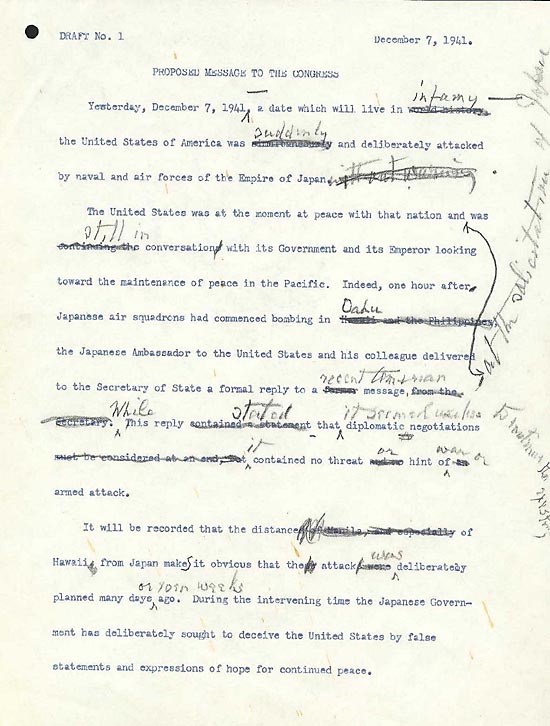
Huh. The Belgium of the Far East.
I couldn't agree with you more. And while Kimmel and Short were "retired", MacArthur should have been court-marshaled for his sheer ineptitude.
Disclaimer: Opinions posted on Free Republic are those of the individual posters and do not necessarily represent the opinion of Free Republic or its management. All materials posted herein are protected by copyright law and the exemption for fair use of copyrighted works.